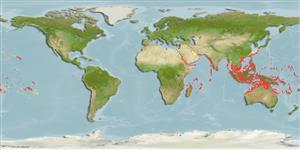分类 / Names
俗名 | 同种异名 | Catalog of Fishes(属, 种) | ITIS | CoL | WoRMS | Cloffa
Elasmobranchii
板鳃亚纲 (鲨鱼与 鱼) (sharks and rays) >
Carcharhiniformes (Ground sharks)
白眼鮫目 (Ground sharks) >
Carcharhinidae (Requiem sharks)
白眼鮫科 (Requiem sharks)
Etymology: Carcharhinus: karcharos (Gr.), sharp or jagged; rhinus, an ancient name for sharks, from rhine (Gr.), rasp, both words alluding to a shark's jagged, rasp-like skin (See ETYFish); melanopterus: melanos (Gr.), black; pterus, from pteron (Gr.), fin, referring to its black-tipped fins (See ETYFish).
More on authors: Quoy & Gaimard.
Environment: milieu / climate zone / depth range / distribution range
生态学
海洋; 半咸淡水 礁区鱼类; 非产卵性溯降河的 (Ref. 51243); 深度上下限 0 - 75 m (Ref. 37816). 亞熱帶的; 35°N - 25°S, 7°E - 134°W
Indo-Pacific: Persian Gulf (Ref. 68964), Red Sea and East Africa to the Hawaiian Islands and the Tuamoto Archipelago. North to Japan and south to Australia. Apparently rare or absent in the more easterly groups. Also eastern Mediterranean (through the Suez Canal).
印度-太平洋: 紅海而且東非到夏威夷群島與 Tuamoto 列島。 顯然稀有或不存在於比較東的群。 也地中海東部.(經過蘇伊士運河)
Length at first maturity / 大小 / 重量 / 年龄
Maturity: Lm 102.0, range 91 - 120 cm
Max length : 200 cm TL 雄鱼/尚未辨别雌雄; (Ref. 5578)
背棘 (总数) : 0; 臀棘: 0. A small shark with a short, bluntly rounded snout, oval eyes, and narrow-cusped teeth; 2nd dorsal fin large; no interdorsal ridge (Ref. 5578). Yellow-brown above, white below; all fins conspicuous with black or dark brown tips also anterior and posterior dark edging on pectoral fins and upper lobe of caudal fin; a prominent black tip of first dorsal fin set off abruptly by a light band below it; a conspicuous dark band on flanks, extending rearward to pelvic fins (Ref. 9997).
一种小的鲨鱼有一个短, 钝地圆的吻,椭圆形的眼与细尖的齿; 第二背鳍鳍大的; 没有间背脊.(参考文献 5578) 背面黄褐色的, 腹面白色的; 所有的鳍显着的有黑色的或深褐色的顶端也在胸鳍与尾鳍上叶上的前面与后面的黑边缘; 一个第一背鳍的突出黑色顶端在它之下突兀的出现一个淡色的条纹了; 在侧面上的一个显着的深色条纹, 在背后对腹鳍延伸.(参考文献 9997)
Inhabits shallow water close inshore on coral reefs and in the intertidal zone (reef flats), near reef drop-offs and close offshore (Ref. 244, 58302). Also found in mangrove areas, moving in and out with the tide (Ref. 6871) and even in fresh water, but not in tropical lakes and rivers far from the sea (Ref. 9997). Occurs singly or in small groups (Ref. 244, 54301). Prefers fishes but also feeds on crustaceans, cephalopods and other mollusks (Ref. 6871). Viviparous (Ref. 50449). May become aggressive to spear fishers and has been reported to bite people wading in shallow water (Ref. 6871). Reported to cause poisoning (Ref. 4690). 2 to 4 young of 46 to 52 cm are born per litter (Ref. 1602). Generally marketed fresh (as fillet), may be dried, salted, smoked (Ref. 5284) or frozen (Ref. 9987). Fins are valued for shark-fin soup (Ref. 9987); liver as source of oil (Ref. 9997). This species is commonly seen in public aquaria (Ref. 54301). Maximum reported weight from IGFA was 13.550 kg (Ref. 40637). Minimum depth reported taken from Ref. 128797.
在礁海峭壁与接近外海的附近, 在珊瑚礁上与在潮间带 (礁石平台) 中栖息于浅水区近岸。 (参考文献 244) 也发现于红树林区域, 搬进与在外随着潮水 (参考文献 6871) 甚至在淡水中, 但是不在热带的湖中与河远离海洋.(参考文献 9997) 各别地或形成小群鱼群生存。 (参考文献 244,54301) 偏爱鱼也吃甲壳动物,头足类动物与其他的软件动物.(参考文献 6871) 胎生的.(参考文献 50449) 五月对鱼矛渔法变成侵略性而且已经被报告咬在浅水区跋涉的人。 (参考文献 6871) 報告引起毒害。 (參考文獻 4690) 46 到 52 公分的 2 到 4個幼魚出生每胎。 (參考文獻 1602) 通常在市場上銷售生鮮地 (如魚排)了, 可能是乾燥的﹐鹽醃的, 煙燻 (參考文獻 5284) 或凍結.(參考文獻 9987) 鰭被認為有價值的用做魚翅湯;(參考文獻 9987) 如油的來源的肝臟.(參考文獻 9997) 這種是在通常中見到的公眾水族館。 (參考文獻 54301)
Life cycle and mating behavior
成熟度 | 繁殖 | 产卵场 | 卵 | 孕卵数 | 仔鱼
Viviparous, placental (Ref. 50449). Litter size 2-4 pups (Ref. 244) after an 8-9 months gestation period (up to 16 months in some localities) (Ref.58048). Size at birth ranges from 33-52 cm (Ref. 244); 48-50 cm TL (Ref.58048). Distinct pairing with embrace (Ref. 205). Precopulatory and courtship involve the male closely following near the female's vent which could possibly be guided by their sense of smell (Ref. 49562, 47987).印度-太平洋: 紅海而且東非到夏威夷群島與 Tuamoto 列島。 顯然稀有或不存在於比較東的群。 也地中海東部.(經過蘇伊士運河)
Compagno, L.J.V., 1984. FAO Species Catalogue. Vol. 4. Sharks of the world. An annotated and illustrated catalogue of shark species known to date. Part 2 - Carcharhiniformes. FAO Fish. Synop. 125(4/2):251-655. Rome: FAO. (Ref. 244)
世界自然保护联盟红皮书 (Ref. 130435: Version 2024-1)
人类利用
渔业: 商业性; 游钓鱼种: 是的; 水族馆: 公众的水族馆
工具
特别资料
下载 XML
网络资源
Estimates based on models
Preferred temperature (Ref.
123201): 23.8 - 28.4, mean 27.4 °C (based on 397 cells).
Phylogenetic diversity index (Ref.
82804): PD
50 = 0.5000 [Uniqueness, from 0.5 = low to 2.0 = high].
Bayesian length-weight: a=0.00468 (0.00257 - 0.00852), b=3.03 (2.88 - 3.18), in cm total length, based on LWR estimates for this species & Genus-body shape (Ref.
93245).
营养阶层 (Ref.
69278): 3.9 ±0.4 se; based on diet studies.
Generation time: 4.4 ( na - na) years. Estimated as median ln(3)/K based on 1
growth studies.
回复力 (Ref.
120179): 低的, 最小族群倍增时间4.5 - 14 年 (Fec=2).
Prior r = 0.26, 95% CL = 0.17 - 0.39, Based on 3 data-limited stock assessments.
Fishing Vulnerability (Ref.
59153): High vulnerability (57 of 100).
Nutrients (Ref.
124155): Calcium = 4.73 [0.83, 25.13] mg/100g; Iron = 0.387 [0.096, 1.146] mg/100g; Protein = 23 [20, 25] %; Omega3 = 0.162 [0.059, 0.403] g/100g; Selenium = 13.5 [4.1, 39.5] μg/100g; VitaminA = 28.8 [9.3, 88.9] μg/100g; Zinc = 0.468 [0.221, 0.937] mg/100g (wet weight);
